 The Tokudama hostas
have been known for a long time in
Japan and the plant was taken to
England by the plant explorer,
Robert Fortune in the mid-1800s.
For decades, this hosta was considered to be a
species, H. tokudama, but it was reclassified
to cultivar status in
The Genus Hosta by W. George Schmid (1991). It is correctly known
as H. 'Tokudama' today.
This slow growing plant forms a medium size
(18 inches high by 44 inches wide)
clump of blue-green foliage that is heavily corrugated, slightly
cupped with thick substance. This type bears dense clusters of
near-white flowers from late June into July.
According to
Zilis (2000)"...'Tokudama'
can be thought of as a
smaller version of H. 'Elegans'."
The New Encyclopedia of Hostas by
Diana
Grenfell (2009) states: "Keeps its color for longer in shady sites. Very
slow to increase...Frequently produces sports. An
excellent breeding plants."
 In
his presentation at the 2019 Dixie Regional Hosta
Meeting in Delaware,
Mark Zilis
stated that after 6 visits to study hostas in Japan, he still feels that H.
'Tokudama' is a species. In
his presentation at the 2019 Dixie Regional Hosta
Meeting in Delaware,
Mark Zilis
stated that after 6 visits to study hostas in Japan, he still feels that H.
'Tokudama' is a species.

An article about H. tokudama by Warren I. Pollock in
The
Hosta Journal (1985 Vol. 16) states that, "A possible
translation is "advantageously round," in reference to the leaf shape."
Marvin C. Eisel, Hosta Registrar
wrote in
The
Hosta Journal (1985 Vol. 16) that, "In the Fall
1984 The American Hosta
Society Newsletter, page 12, I reported that I had registered in the name of
The American Hosta
Society, the cultivar name 'Golden Sunburst' for the golden forms
of H. '
Frances Williams' and 'Golden Medallion' for all the golden
mutations of H. tokudama."
 Bob Solberg, hybridizer and past President of the
The
American Hosta Society wrote in
The
Hosta Journal (1993 Vol. 24 No. 1) that
“For H. ‘Tokudama’ to be considered a species we must find a
reproducing population of it growing naturally,
(“spontaneously”), in the wild; a collector’s garden, even in
Japan, will not suffice…We first find the plant in 1860 in
Nagasaki in the garden of
Von Siebold…Was it a wild plant, or just a cultivar from the
garden? We do not know…Robert Fortune obtained a plant from Von Siebold and took it back
to England…Von Siebold brought the rest of the clump back
home…From England and Holland it came to America, then into the
test tube and now they are everywhere, even shipped back to
Japan. All from a single clone, not a population of wild plants
but a selected individual. Thus, H. ‘Tokudama’ as pictured by Regel and grown by you and me is a cultivar.” Bob Solberg, hybridizer and past President of the
The
American Hosta Society wrote in
The
Hosta Journal (1993 Vol. 24 No. 1) that
“For H. ‘Tokudama’ to be considered a species we must find a
reproducing population of it growing naturally,
(“spontaneously”), in the wild; a collector’s garden, even in
Japan, will not suffice…We first find the plant in 1860 in
Nagasaki in the garden of
Von Siebold…Was it a wild plant, or just a cultivar from the
garden? We do not know…Robert Fortune obtained a plant from Von Siebold and took it back
to England…Von Siebold brought the rest of the clump back
home…From England and Holland it came to America, then into the
test tube and now they are everywhere, even shipped back to
Japan. All from a single clone, not a population of wild plants
but a selected individual. Thus, H. ‘Tokudama’ as pictured by Regel and grown by you and me is a cultivar.”
An article about H. 'Pelham Blue Tump' by Warren I. Pollock in
The
Hosta Journal (1995 Vol. 26 No. 2) reports that, "Pelham
is the name of Dick
Kitchingman's home in Dorset,
England. Tump is an old
English word for a small mound...a small plant with blue-green leaves. It's a 'Tokudama'
hybrid."
 In
a similar article about H. 'Buckshaw Blue' in
The
Hosta Journal (1996 Vol. 27 No. 1 )Warren I. Pollock says that, "This is
a superb hosta that has won several
AHS awards: 1980 Midwest Blue Award and 1987
Nancy Minks Award. It is a seedling found by Eric
Smith at the
Hilliers
Nurseries, Winchester,
England, and taken by him to Buckshaw Gardens from which
it received its name...is considered to be a member of the Tokudama Group. H. 'Buckshaw
Blue' is one of the best blue hostas, but be warned: It is very slow growing." In
a similar article about H. 'Buckshaw Blue' in
The
Hosta Journal (1996 Vol. 27 No. 1 )Warren I. Pollock says that, "This is
a superb hosta that has won several
AHS awards: 1980 Midwest Blue Award and 1987
Nancy Minks Award. It is a seedling found by Eric
Smith at the
Hilliers
Nurseries, Winchester,
England, and taken by him to Buckshaw Gardens from which
it received its name...is considered to be a member of the Tokudama Group. H. 'Buckshaw
Blue' is one of the best blue hostas, but be warned: It is very slow growing."
Tom Micheletti,
former President of The American Hosta Society
in
The
Hosta Journal (2001 Vol. 32 No. 1) took on the task of listing the
"Classic Hosta Cultivars" through the year 2003. He decided to divide these into
categories including: Green,
Blue,
Yellow (Gold,
White-Margined,
Yellow-Margined,
White Medio-Variegated
and Yellow
Medio-Variegated. No other genus in the plant kingdom has
as many blue-leaved variants...Grandaddy of the blues would be H. 'Elegans'
. H. 'Tokudama' would be the other parent that
has passed along the blue leaf characteristics.
Author of The Genus
Hosta, W. George Schmid
wrote in
The
Hosta Journal (2009 Vol. 40 No. 3) that, "Over
the last 40 years I have learned that any plant with
H. 'Sieboldiana' or 'Tokudama'
in its background cannot stand drought."
Another article by Warren I. Pollock in
The
Hosta Journal (2014 Vol. 45 No. 1) states that,
"...information from Dr. Kevin C. Vaughn...suggests that H. 'Bengee' likely is
the pollen parent of the popular 'Sum and Substance'. ..What made 'Bengee' so
interesting and desirable in the 1960s, especially to breeders, was it being the
first all-gold 'Tokudama' type." Florence Shaw used it heavily as a parent,"
Kevin recalled."

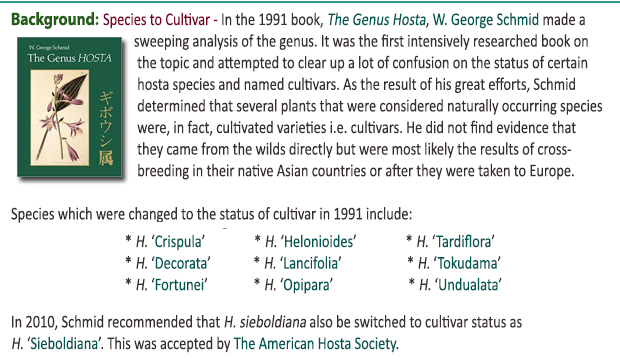
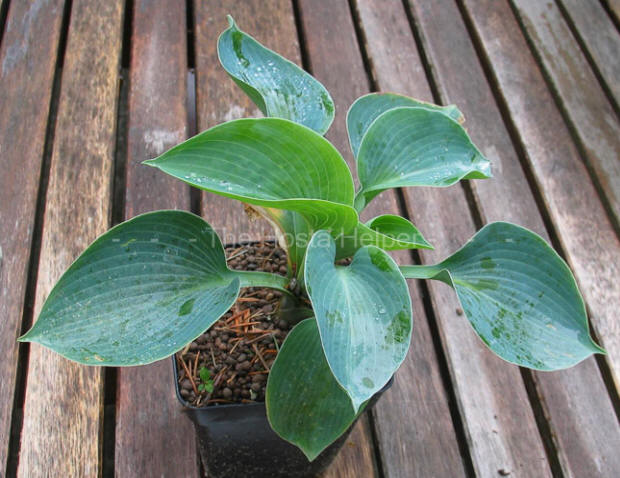

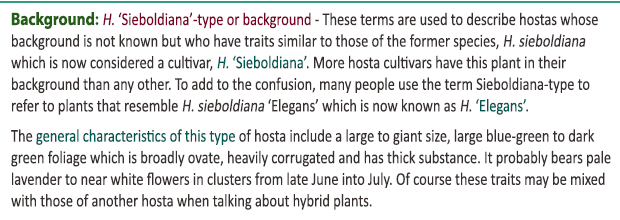



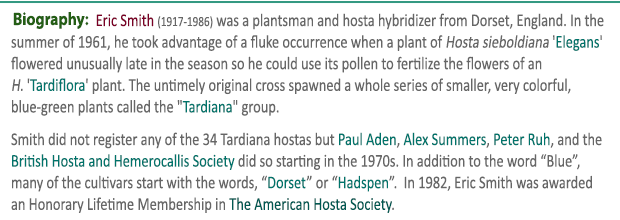
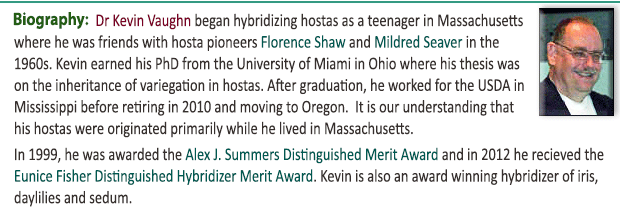


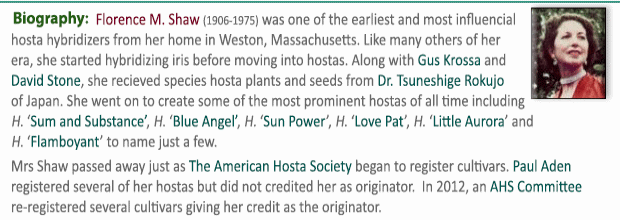
 |



